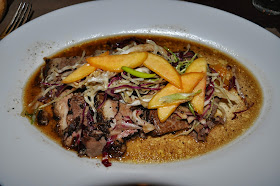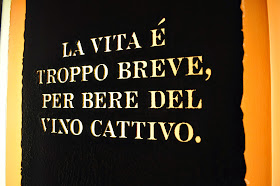640 N Broad St, Philadelphia, PA 19130 (215) 763-0920
Osteria opened in 2007 and has since become one of the East Coast's most famous Italian restaurants garnering much critical acclaim. Chefs Marc Vetri and Jeff Michaud certainly do the restaurant justice. An osteria in Italy was originally a place serving wine and simple food. Lately, the emphasis has shifted to the food, but menus tend to be short, with an emphasis on local specialties such as pasta, grilled meat or fish, and often served at shared tables. Ideal for a cheap lunch, osterie (the plural in Italian) also cater for after work and evening refreshment. Osterie vary greatly in practice: some only serve drinks and clients are allowed to bring in their own food; some have retained a predominantly male clientele whilst others have reached out to students and young professionals.
Very appropriately, the restaurant signage incorporates a bottle of wine in the process of being uncorked to suggest the Italian origins of the name.
Simple flowers decorate the wooden tables to give the restaurant a rustic feel in keeping with a traditional osteria theme.
A spacious dining area with open air vistas onto the patio and an enclosed glass seating area give one the feeling he is outside in an open air market.
I would be remiss if I did not mention this cocktail. It was one of the best I've had this summer. Osteria makes their own limoncello to give their Sicilian Lemonade the most delicious flavor.
Sicilian Lemonade: house made limoncello, fresh mint, lime.
Limoncello is made from lemon zest, or peels without the pith, steeped in rectified spirit (pure ethyl alcohol 95% ABV) until the oil is released. The resulting yellow liquid is then mixed with simple syrup. Varying sugar to water ratio and temperature will affect the clarity, viscosity, and flavor.
To start the meal off we chose the special: Osteria's take on a classic Italian dish: the bruschetta. It was not quite as amazing as I had hoped given the hype over this restaurant. However, I was already on my second mouth-watering Sicilian Lemonade, so I didn't really pay too much attention to this obvious faux pas. The bread was a little too charred for my taste and the tomatoes were either soaked in juice or were just saturated too long because they were literally the consistency of an over-ripened peach. They didn't taste bad by any means, but I'm used to a little more crunch to my tomatoes. This is of course personal preference talking here as I'm sure others would love some squishy tomatoes but I like a little crunch in my bunch of veggies.
Next up, in my quest for being a culinary-adventurer, I decided on the grilled veal sweetbread spiedini with stonefruits and pine nuts. The term "spiedie" comes from the Italian spiedo meaning spit or spiedini referring to cubes or balls of meat cooked on a skewer. Hence we are able to see the sweetbread (spiedini) served on a skewer (spiedo). Sweetbread of course refers to thymus (also called throat, gullet, or neck sweetbread) or the pancreas (also called heart, stomach, or belly sweetbread), especially of the calf (ris de veau) and lamb (ris d'agneau), and less commonly of beef and pork. Since veal is generally produced from young male calves, I'm assuming I was eating pancreas, but it is of course impossible to tell. The sweetbread itself is very chewy and largely tasteless which is balanced by the sweetness of the stonefruit and pine nuts. The pine nuts are the small yellow seeds visible while the stone fruit are the orange fruits surrounding the skewer.
My dinner companion's mozzarella cheese balls with tomato sauce was decidedly better than the sweetbread.
Not much to say here. They were competently prepared, in my opinion, presentation was a bit lacking, but overall, tasted good.
Grilled wild Alaskan king salmon with zucchini, herb oil and salmon terrine. Terrine is a French forcemeat (mixture of ground, lean meat emulsified with fat) loaf similar to a pâté, made with more coarsely chopped ingredients. So in this dish, the terrine would be the pink half circle wrapped in the zucchini skin. The salmon itself was a bit raw for my taste. I like the fish to be pink (medium preparation) while this salmon seemed at any moment ready to swim off my plate. I also prefer the salmon to be descaled , but that is personal preference. It wasn't bad, but as my friend would say, "I was eating it because it was there." He also commented that it looked a bit raw to him as well.
While my batting average of the evening stood at 0-2, this was decidedly the redeeming deus ex machina of this culinary performance. This was the smoked creekstone farm brisket with peach and radicchio. The bitter, spicy taste of the purplish radicchio was balanced by the sweetness of the peaches. A true ambrosia. The brisket was tender and sweet--a true feat considering its origins. Brisket is a cut of meat from the breast or lower chest of beef or veal. The beef brisket is one of the nine beef primal cuts, though the precise definition of the cut differs internationally. The brisket muscles include the superficial and deep pectorals. As cattle do not have collar bones, these muscles support about 60% of the body weight of standing/moving cattle. This requires a significant amount of connective tissue, so the resulting meat must be cooked correctly to tenderize the connective tissue. This was hands down the best dish of the evening and any foodie should get the brisket. It will be a boisterous uproar I predict when this specimen is taken off the menu.
Although already stuffed, gluttony is one of the chief virtues of any food critic. And I would chastise myself later if I passed up a raspberry and pistachio linzertorte with lemon verbena gelato. Wouldn't you? Dessert was no doubt delicious but I was so stuffed at this point it made hardly any difference. It is difficult to do anything bad when you mix raspberries and pistachio. Of note, the Linzer Torte (or Linzertorte) is an Austrian torte with a lattice design on top of the pastry. It is hard to see due to the confectionary sugar, but it is present. Lemon verbana is a leafy plant that adds a fresh, lemon flavor to any dish, in this case, the gelato.
In Other News:
High ceilings cast a nice glow and ambiance to the restaurant.
A private dining area seats 50 for parties or special events.
Bathrooms are clean and nicely furnished.
A gorgeous glass-enclosed patio lets diners enjoy a natural lit dining experience.
The open bar and kitchen area gives restaurant patrons a sense of honesty in the food being crafted.
A lighting detail featured on the high ceilings.
Featured on a wall panel:
La vita è troppo breve per bere vino cattivo. Life's too short to drink bad/cheap wine.
The bar area, detail.




















No comments:
Post a Comment